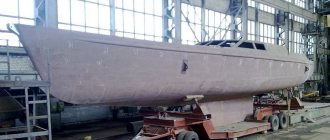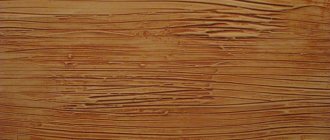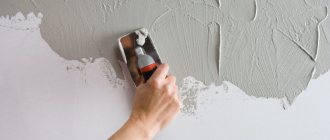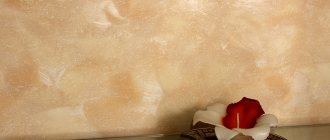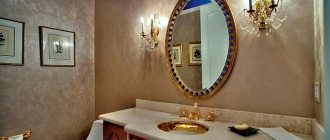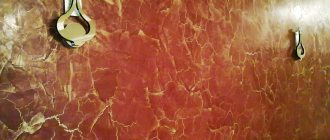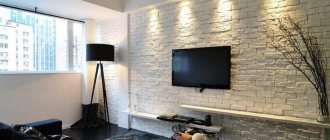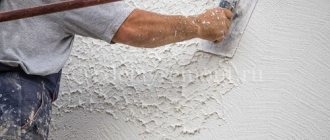Decorative plaster is a modern way to protect and decorate buildings, however, at the same time it is a very responsible job. If the material is applied with high quality, the appearance of the house will be attractive, moreover, the consumption of the composition will be minimal, and its durability will be maximum. In order for the solution to adhere very firmly and efficiently to the surface, before applying decorative plaster, it is necessary to use a special primer that is treated with the building. Experts in the field of construction and finishing say that a primer for decorative plaster must be used, and it must be applied correctly, in accordance with the technology.
Extension of service life
In order for the plaster layer to have maximum service life, it is necessary:
- qualitatively level the surface vertically and horizontally;
- apply the finishing type of putty to seal all cracks and irregularities;
- apply a special primer to the surface of the walls, thanks to which the decorative finish will adhere well;
- make the base surface strong enough for further finishing work.
To carry out all of the above work, you first need to find out what materials the building is constructed from and assess the technical condition of the walls. For example, if the base is porous, made of brick, concrete or wood, and also if it is an internal surface, then it must be treated with deep penetration soil. This composition allows the surface to be vapor-permeable, and at the same time, the finishing material adheres well to the base coat. To perform external facade finishing work, completely different types of soil are used. It is advisable to purchase primers containing antiseptic additives, thanks to which mold and fungi will not appear on the surface of a building finished with plaster. If the walls are loose, then primer compositions that have a strengthening effect are used. Thanks to them, the density will be significantly increased and the adhesive characteristics will increase significantly. These types of soil can even be used for applying to a lime layer, because if this is not done, then after a few years the finishing material will begin to deteriorate.
Types of primers
There are several types of primers that are used in different conditions:
- deeply penetrating;
- adhesive;
- universal.
A deeply penetrating primer for decorative plaster is necessary in situations where work will be carried out on a porous surface. They are able to strengthen the base for putty, while simultaneously filling the pores in the wall material. Adhesive primers are designed for use on low-adhesion surfaces.
These grounds include:
- concrete walls and slab floors;
- painted surfaces.
Primers are available for indoor and outdoor use. Their characteristics are slightly different from each other.
Universal primer for decorative plaster is applied to the following types of surfaces:
- brickwork;
- layer of plaster;
- drywall.
This type of material is used on surfaces that are not very smooth. It is suitable for creating a base on which structural plaster will subsequently be applied.
They have a number of useful properties:
- improve the level of adhesion;
- make the base stronger.
After their use, a film is formed on the surface, which reduces the consumption of plaster mortar.
For interior work
For work in the building, materials are selected that are safe for human health and do not emit harmful substances when dried. If the room is damp, then you cannot use products intended for dry areas.
For external work
Putty used for exterior work should be characterized by increased:
- frost resistance;
- hydrophobicity;
- vapor permeability;
- weather resistance.
Deep penetrating
A primer of this type is necessary on walls with a highly dusty surface, these include gypsum and chalk coatings. This material will be needed to prepare walls made of silicate blocks. This composition is created on the basis of modified polymers that are capable of penetrating deep into walls and, when dry, completely covering existing cavities.
This effect can be achieved due to the fact that, unlike simple primers, deep-penetrating primers consist of smaller particles. After drying, the simple material remains only on the surface of the capillaries.
Adhesive
The peculiarity of these soils is that they necessarily contain quartz sand and polymers. Sand provides good adhesion to the surface.
This material is multi-component, because its composition, in addition to polymers and sand, includes:
- glue or other ingredients that form a film on the surface;
- drying accelerators;
- substances that make the mixture waterproof and protect against the spread of mold fungi.
The consumption of this mixture increases if it is applied to a porous surface. Experts advise not to skimp on putty if the next layer of finishing is an expensive material. This tool has its advantages and disadvantages. It adheres well to the surface and is a good base for decorative putty. At the same time, sometimes it has to be diluted with water, because... the mixture is too thick.
Universal
This primer can be used on almost any type of surface. It immediately has all the features inherent in highly specialized primers. The main quality of this material is to improve the characteristics of the treated area.
The mixture is available in 2 versions:
- Acrylic, which necessarily contains acrylic polymers.
- Deep, designed for deep impregnation of the base.
The consumption of the primer largely depends on the number of layers applied and the porosity of the surface. After using it, the wall acquires a dense, uniform structure.
Concrete contact
This mixture must include:
- Acrylic dispersion. An important component that ensures adhesion and leaves behind a sticky layer. The quality of the entire primer depends on this component.
- Fillers. Only natural, mainly quartz sand is added, but other options can be selected depending on the manufacturer.
- Supplements Provides moisture resistance and resistance to fungal infection.
- Some manufacturers add dye to the composition so that the primer layer is clearly visible.
Acrylic
This type of primer eliminates any unevenness and closes any pores on the surface. It is a liquid solution that primarily performs a protective function. The soil is perfectly absorbed into the base and prepares it for applying the next layer.
Alignment
Before carrying out finishing work, the area must be leveled. This can be done in various ways, but the hanging method is considered the most effective and efficient. First, the area is marked diagonally using dowels, then a measuring thread is pulled between the driven dowels. Then, using this thread, you can see where the surface needs to be leveled and how much. Before plastering, you can smooth out the gaps using putty. When it is completely dry, it needs to be primed. If there are large protrusions and excess mortar, they can be knocked off with a hammer or chisel. Thanks to high-quality and scrupulous leveling, the consumption of expensive decorative plaster will be significantly reduced. In the event that the surface is very uneven, when the gaps are 4-5 centimeters or more, then experts recommend leveling not by plastering, but by other methods:
- creating a smooth metal frame;
- upholstery of walls with wooden shingles.
The metal frame, of course, significantly increases the load-bearing capacity of the wall area, but it is used less often than wooden shingles. Why? Because metal is significantly more expensive, and it also needs to be coated with an anti-corrosion compound to extend its service life.
Puttying under decorative paint
Preparing the surface for painting with decorative paint is a more complex process. After the puttying stage (before applying the impregnating primer), be sure to inspect the wall surface using a special lamp or spotlight.
- Cement-sand mixture:
stick on a 2x2 mm reinforcing mesh, one layer of polymer or mineral putty, two layers of “superfinish” putty - Gypsum plaster:
one layer of polymer putty, one or two layers of “superfinish” putty - GKL, GVL:
- one or two layers of “superfinish” putty - Fiberboard, chipboard, TSN:
- stick a 2x2 mm reinforcing mesh, one layer of polymer or mineral putty, two layers of “superfinish” putty - Aerated concrete, plaster and other blocks:
stick on a 2x2 mm reinforcing mesh, one layer of polymer or mineral putty, two layers of “superfinish” putty
Primer selection
The primer applied under decorative plaster can be divided into several categories:
- alkaline, acidic or neutral;
- various indicators of adhesive properties;
- different viscosity of the composition;
- suitable for a certain type of plastering.
If there are many external defects on the walls, such as rust stains, salt deposits, and others, then you need to purchase primer with a high alkaline composition, the pH of which is 8 or more, to hide these defects you need to use a deep penetration primer. This mixture neutralizes any salts, even very deep ones. Rust must be removed, as it reduces the adhesion rate, destroys the wall and the primer if the mixture is chosen incorrectly. Low pH soils are suitable for application inside buildings where air humidity is low. In this case, the soil consumption will be much less than outside the house.
Why do you need a primer for plastering walls?
Primers perform several functions:
- penetrating deeply into the structures of the base base, they strengthen its upper layers for the subsequent application of a plaster layer. If it becomes necessary to remove the finishing layer, then you don’t have to worry about the condition of the base. It will maintain its integrity and will not require additional repairs;
- provide high adhesion of the base to the finishing material. Due to the porosity of the base surface, when plaster is applied to the wall, moisture is quickly absorbed from the finishing layer. For this reason, when drying, you can observe the peeling of the plaster layer - it simply does not “stick” to the wall. Coating the walls with a primer for plaster creates more favorable conditions for subsequent work. After it dries, a thin rough film is formed on the base, which prevents the absorption of moisture from the finishing layer and increases the adhesive properties of the base;
- ensure the resistance of base surfaces to the negative effects of environmental factors - prevents the penetration of moisture into the enclosing structures from the outside, even under heavy rain loads.
Photo 2. Applying primer for plastering walls
Puttying
When the walls are plastered, they must be puttied, be it external or internal surfaces. You need to select putty depending on the type of plaster or the type of building materials used to construct the building. In order for decorative plaster to be durable and hold firmly, you need to choose the right primer mixture, otherwise the layer of plaster will peel off completely or partially. To prevent this from happening, it is necessary not to use putty consisting of highly viscous substances, as well as those that do not absorb moisture well, for example, you should not use oil putty, glue, or primers based on alabaster.
Primer of walls for plaster, why is it needed?
Each treated surface differs both in structure and in its own set of physical and mechanical characteristics, such as adhesion, adsorption or wettability. In order to ensure the predicted result (quality), they resort to a kind of “intermediary” - an intermediate layer of a special composition, which makes it possible to bring the mentioned physical properties to a certain average level:
- Level out unevenness. Thus, the primer for brick under plaster will differ in composition from that needed for wood;
- Increase the level of adsorption. Glue and paint last longer on a pre-treated surface;
- Ensure the required degree of adhesion, for example, for wallpapering walls;
- Get a protective waterproofing effect. Some materials become saturated with moisture over time and become unusable.
The primer for brick under plaster will differ in composition from that needed for wood.
Correct priming
Before applying a layer of decorative coating, the following conditions must be met:
- prime the area at least twice, the thickness of the layers should be approximately 1 centimeter, more is possible. If you prime with a thin layer, then such protection will be insufficient; it will poorly hold heavy plaster on the wall. Naturally, the thicker the layer, the greater the material consumption;
- The primer can be applied either with a wide brush or with a roller. You should not use narrow brushes, because the layer of soil will lie unevenly, and it will be difficult to maintain the same thickness. Also, experts do not recommend using a spray gun, vacuum cleaner or spray gun, because due to the use of these devices, the quality of the coating will suffer and soil consumption will increase. In addition, deep penetration soils will not be able to penetrate deep enough into the walls if spraying devices are used. The consequence of this will be peeling of the decorative coating some time after application;
- Upon completion of priming, it is necessary to wipe down the treated areas. This operation must be performed for external and internal work. Thanks to grouting, the soil layer is significantly compacted, this will enable the decorative coating to adhere well to the surface;
- The soil should not be allowed to dry out, so before plastering it is periodically moistened. This can be done with plain water, which can be applied with a spray bottle. Decorative types of plaster are of much higher quality and are easier to apply to slightly damp walls. It is very important to do this, especially for interior walls.
Process Details
Alignment done in advance is an important nuance
Leveling surfaces before work is done in several ways, but the most practical, and also giving good results, is the hanging method. The part of the walls to be decoratively plastered is marked diagonally using dowels, and then a measuring cord should be used between them using a plumb line. By the sag of the cord you can judge where and how to level the walls. The size of the gap before plastering can be partially eliminated using putty, and after that the surface will be primed. Excess product can be knocked off with a chisel or scraper. At the same time, the consumption of primer per square meter increases, but the need for more expensive decorative plaster will decrease.
It also happens that the gap is very large and even more than 4-5 cm. In this case, leveling and further priming the walls will not give the required result. There are two options for the development of events before processing:
- Upholster the surface using shingles.
- Build a metal frame.
By the way, the latter, although it will increase the load-bearing capacity of decorative plaster, is used much less frequently in practice. The reason for this may be increased costs, as well as the need to use steels that have an anti-corrosion coating or aluminum strips.
Features of primer selection
Compositions of primers for decorative plaster are classified:
- According to pH indicators, pH is alkaline, acidic and neutral.
- According to the degree of increase in the adhesion indicators of the primed surface.
- According to the viscosity of the compositions.
- If possible, work with certain types of decorative plaster.
The first indicator is important for the ability of the primer to hide, or vice versa, to highlight characteristic surface flaws on the walls. These include rust stains and salt deposits, which very often appear after lime treatment of external walls. If there are a large number of such surface defects, you should only use primers with an alkaline composition, the pH of which is the highest (from 8 or more units), and at the same time, the compositions have deep penetration. In this case, salt neutralization occurs during priming, as a result of which even very deep stains will disappear. The same will apply to rusty surfaces, and it has an aggressive effect on adhesion because it destroys not just the wall surfaces, but also the primer if it is chosen incorrectly.
Please note that a primer that has a reduced pH value is suitable for treating interior wall surfaces in rooms with normal or even slightly reduced humidity levels. For such premises, the specific consumption of primer per square meter is reduced.
Requirements for puttying
After plastering work is completed, any external and internal surfaces should be puttied. Putty compositions are also selected according to the degree of relationship with plaster compositions. A fairly important parameter that determines the durability of a decorative type of plaster will be the compliance of the selected product with it. Otherwise, after priming, partial or even complete peeling of the plaster composition may occur. Often, to avoid running into such trouble, you should avoid using putties that contain substances with high viscosity and have a low degree of absorption (for example, putties based on alabaster, adhesives, oil putties).
Priming process technology
Features of priming wall surfaces under the application of decorative plaster are as follows:
Only deep priming in two layers is used, and the thickness of each layer must be at least 1 cm. A thinner layer will not ensure retention of heavy material on wall surfaces. The primer consumption per square meter will increase.- A wide paint brush or roller should be used as a working tool - the use of thin brushes will not provide the required thickness and uniformity to the primer layer. You should not use a vacuum cleaner, spray gun or even a spray gun for this purpose of imaginary acceleration of work - the consumption of primer per square meter will increase, but the quality of the coating will become much worse. This is due to the fact that a deep penetration primer does not allow components to penetrate deep into the treatment surface. As a result, decorative plaster after application will begin to peel off from the surface of the treatment.
- After priming the walls for decorative plaster, the treatment surface is immediately grouted. A similar operation is performed for external and internal walls. As a result, the layer will become compacted and will subsequently provide an excellent base for decorative types of plasters.
- To prevent the primed surface from drying out, it should be moistened during the entire time period before plastering. The simplest flower trimmer or spray bottle will do. The reason is that decorative plaster is applied much easier and better on slightly moistened surfaces, and this is extremely important for interior surfaces in residential premises.
A primer used before applying decorative plaster will provide the finishing surface with the required level of durability. Its consumption per square meter is 1/5 liter and depends on the wall materials, as well as the condition of the original coating.
How and with what should I level the wall before applying plaster? Important nuances
There are several ways to level the surface, however, the hanging method has proven itself to be the most effective.
The essence of the method is that a measuring cord is placed between the dowels driven diagonally into the wall using a plumb line. Based on the resulting sags in the cord, they can determine which places and with the help of which techniques need to be leveled.
Small gaps can be eliminated using putty. After applying and drying the composition, the excess is removed and the exterior is primed.
The increase in primer costs is fully justified by the subsequent savings on the plaster itself, the cost of which is significantly higher.
To eliminate significant gaps (more than 40 mm), you will have to use one of the methods before priming: cover the surface with shingles or use a metal frame.
The first method is the most cost-effective, because To correct irregularities using a metal frame, expensive materials are used, which significantly increase repair costs.
What needs to be done BEFORE applying decorative plaster?
- The base wall must be level in all directions
- All irregularities have been eliminated. For this purpose finishing putty is used.
- High-quality adhesion of the surface of the base and the decorative layer is ensured
- The starting base must be strong
In order for the result to be optimal, at the preparation stage it is necessary to take into account the material and the initial condition of the walls.
Based on this information, select the primer mixture:
- To ensure vapor permeability and increase adhesion on solid porous surfaces such as concrete, wood or brick, deeply penetrating primers are used. In their composition one can often find fungicidal components that protect the decorative wall from mold and mildew, which are practically not removed from the internal walls in the decoration of which plastering material was used;
- in buildings where the base was treated with lime mortar, which is known for its property over time to destroy the surface of the decorative wall on which it is applied, it is necessary to use a primer with a strengthening effect. These compounds compact the exterior material and improve adhesion between the base and the plaster.
What primer should I use under decorative plaster?
Priming surfaces before applying leveling and finishing layers as a technological process in construction has been used not very long ago. Today it is clear that many stages of construction and renovation cannot be done without them. Often consumers do not know what primer to use for plaster, what primer is needed for tiles, paint, putty. Which primer is best to choose for a specific task, when and how to use the primer?
Let’s briefly look at what primers are needed for and the specifics of their use. Primers for mineral bases in construction can be divided into several groups.
- Deep penetration soils, strengthening, made in the form of solutions of acrylic dispersions.
- Water-soluble silicate or silicone primers. They are usually used in painting systems or when applying ready-to-use decorative plasters, silicate or silicone, respectively.
- Contact soils containing quartz sand. These primers form a rough, translucent white or colored film on the surface of materials.
- Special restoration primers used in material systems in the special segment of construction, repair or restoration work.
The main instructions of any manufacturer for preparing the base: “The base must be dry, strong and stable, free from dust, dirt, grease or oil stains, as well as other substances and formations that impede adhesion.” This is the ideal to which every builder should strive. But, like any ideal, in real conditions it is difficult to achieve. Primers have greatly simplified the surface preparation technology described above. Modern universal primers solve a number of main problems in surface preparation:
* reduction of water absorption of the base,
Let's consider separately primers for facade work under finishing plasters. All manufacturers recommend using soil with quartz sand to prepare walls for decorative plaster “Bark Beetle” or “Shuba” and various mosaic plasters. There are two main such primers in the ATLAS line of materials.
ATLAS SILKON ANX
– primer for silicone plaster and silicone-silicate plaster.
This silicone facade primer primes the base for thin-layer silicone and silicone-silicate plasters. ATLAS SILKON ANX composition is an aqueous dispersion of synthetic resins. Contains quartz chips - increases adhesion due to a significant expansion of the effective surface between layers. It forms a rough surface, which makes it easier to apply the next layer, as it prevents the applied plaster from “sliding.” Protects the base from the adverse effects of the new layer - acts as a chemical barrier between the base and the plaster, limiting their mutual reactions - limits color penetration from the base and the appearance of stains on the surface of the plaster. It has a high level of adhesion - to concrete at least 1 MPa. This primer for decorative plaster limits the absorption of the base - it prevents too intense moisture transfer to the base of freshly applied plaster.
Primer for decorative plaster is an important component of the facade finishing system; the primer contains quartz flour and serves as an important link between the base and decorative plaster of the facade SILKON ANX or ASX primer for silicone and silicate decorative plasters
ATLAS CERPLAST
– Primer for mineral plasters, as well as acrylic and mosaic plasters. This primer for decorative plasters provides ideal adhesion to the base, evens out absorption and strengthens the base. It is a primer for facades, facilitates application and formation of texture, and evens out the color of the base. This ready-made construction primer is available in white, but can be tinted into available colors to match selected dark colors of DEKO M mosaic plasters.
